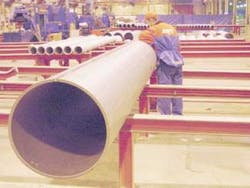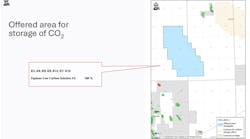AvestaPolarit applying deep I-groove welds to improve productivity and uniformity
AvestaPolarit Stainless Tube (AST) plans to upgrade its folding press to increase the wall thickness of stainless steel accommodated by its plant in Storfors, Sweden. The company, owned 83% by AvestaPolarit and 17% by Sandvik, wants to raise its wall thickness threshold from 35 mm currently to 55 mm, in line with recent market enquiries. This will entail rebuilding the 10,000-metric-ton capacity folding press, said Jan Boberg, AST Storfors general manager.
null
The increased wall thickness will in turn require use of special welding treatment. Because welding filler can be expensive, Boberg said, the goal is to decrease the amount of filler used per weld. To this end, AST is investigating plasma arc welding designs, which typically offer a penetration of 5-10 mm.
"But we will weld to 20 mm with the new technique," said Kenan Cosic of AST's marketing support division.
Current welds, conducted using the Y-groove technique, necessitate application of a plasma level weld, a tungsten inert gas weld for the inside level, and finally submerged arc welding outside to seal the pipe. The I-groove method will require one weld only, Boberg said.
I-groove welding differs from the current X-groove method for large thicknesses and the Y-groove method for medium thicknesses in that it allows for welding of two parallel surfaces, rather than the welding of angled surfaces common to the X-groove and Y-groove approaches. The I-groove method also consumes less filler material, providing a more uniform steel composition at the weld, Boberg said. Bonuses include higher productivity, with no need for a machined edge before the weld is performed, and also lower welding costs because less filler is used.
null
AST has been welding thick wall test pipes, > 15 mm, with the I-groove method. After final adjustments to the welding designs, the company plans to use the method full-scale later this year. To ease the move to higher thicknesses, AST is also implementing other small changes, such as improving the calibration systems because the tolerances are expected to become more narrow in terms of wall thickness and outside diameter.
Recently, AST supplied 350 metric tons of 316L and 254 SMO pipe with a 700-mm diameter for the Kristin platform in the Norwegian Sea as well as 400 metric tons of pipe for the Troll C platform water injection module upgrade in the North Sea.
"In Norway, there is a big replacement market offshore for pipework," Boberg said.
In January, the AST plant was manufacturing pipe for a desalination plant in Israel. The super duplex 2507 pipes, destined for the corrosive environment of a desalination plant, were a first for AST and could have some interesting applications for the offshore industry. AST also plans to manufacture manifold sections up to 64-in. diameter for both topsides and subsea applications.
For more information, contact Jan Boberg, AvestaPolarit. Tel.: +46 550 653 05, fax: +46 550 653 03, email: [email protected], website: www.avestapolarit.com.





